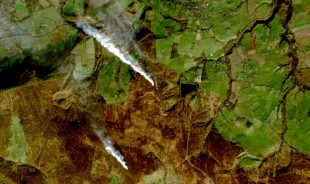About 15 years ago, one of our upland ecologists showed me some aerial photographs of the same area of upland moorland taken across several decades. They showed a very striking picture of the historic increases both in area and intensity of heather burning in our uplands. We talked about whether we could afford to collect more recent aerial photos to bring the sequence up to date. That was the moment that the seed was sown in my mind to look for a faster, more thorough and more economical way to understand, track, measure and record the changes in burning patterns in the uplands.
Fast-forward a decade and the desire to understand the changes in our uplands is even more intense as we focus on protecting the vast carbon stores of our upland peatland, recovering biodiversity, protecting water quality, and slowing the flow of water through the catchment. It was perhaps no surprise then that I gave our newly-formed Earth Observation team plenty of encouragement to see what they could do to bring my vision into reality.
They did not let me down, and Jonathan Brownett from Natural England’s Earth Observation Service tells the story of the development of the Moorland Change Map and how we are now able to produce a detailed annual map of the 2,000 Km² of heather-dominated uplands in England. What’s more, satellite passes are so frequent that we are even able to detect changes over shorter time periods and on clear days even see active burns.

This enables us to compile frequent, accurate and detailed information on moorland changes which will revolutionise our ability to understand how individual moorlands are being managed and advise on their sustainable recovery. For example, we our evidence indicates that the 2018-19 and the 2019-20 burn seasons saw approximately 6-7 per cent and around 3 per cent of our upland moorland burned or cut, respectively, in patches greater than 900m². We are currently working to publish these and future maps.
As the team worked on developing the technical aspects of the moorland change map, I was pleased to be able to help by using my knowledge of my local moorlands to undertake some field validation or data gathering. We have designed a mobile app that allows the recording of burn and cut patches and mature heather, with geo-referenced photographs. This information is then matched up with the satellite images to ‘train’ the analytical tools to automatically pick out the burned or cut patches from the surrounding heather.

What next?
Our work doesn’t stop here, however. As we gather more empirical data, we hope to be able refine our analysis to enable us to distinguish between areas where the heather is burned and those where it is cut. This will prove valuable in understanding any differences in the impact and effectiveness of these two different management interventions.
We also plan to ‘wind the clock back’ a bit to analyse older Sentinel satellite data from the two earlier burn seasons (2016/17 and 2017/18). We may also look further back in time using other imagery that we can then apply modern analytical techniques to. Building up this historical knowledge will provide us with a valuable baseline of the nature, location and extent of rotational burning practice against which we will be able to chart the impacts of forthcoming changes in management practice and the subsequent recovery of our upland moorlands.
In parallel to the work to develop and refine the Moorland Change Map, we have also developed techniques to rapidly produce images and maps of wildfires that occur throughout the year across any area. This service has already proved invaluable in understanding the extent and severity of fires that occur which can then be used in helping shape the location and nature of subsequent habitat recovery actions
I think it is safe to say that the seed that I sowed over a decade ago has sprouted and is growing well.
The Moorland Change Map is on our Access to Evidence pages here.
2 comments
Comment by Rob Yorke posted on
Interesting use of tech, Tim. Assume 'boots on the ground' may still be required to differentiate between managed burns (controlled 'cool burns' and less controlled 'hot burns') and incidents of wildfires.
(ping back to my comment on this NE blog https://naturalengland.blog.gov.uk/2020/11/04/blanket-bogs-a-natural-asset/)
yours etc, Rob Yorke http://www.robyorke.co.uk
Comment by Vaughan Robbins posted on
Thank you for an insight to this developing use of technology. Where this technology has been used to map habitat changes on dunes in Cornwall, the accuracy has been greatly enhance by boots on the ground to verify the imaging and we hope will be useful in site advisory visits when our technology catches up.
Packaging mapping and data sources into to a simple usable hand held app that can be utilised by advisers and site managers in the field is what is needed, otherwise it risks remaining an esoteric art practiced only by GIS professionals.